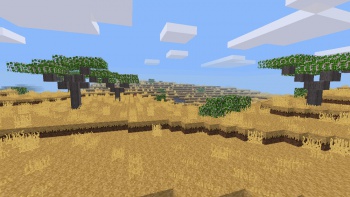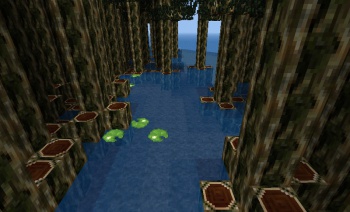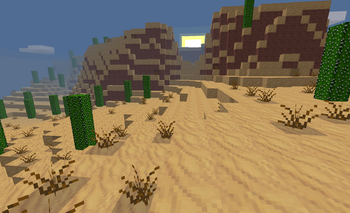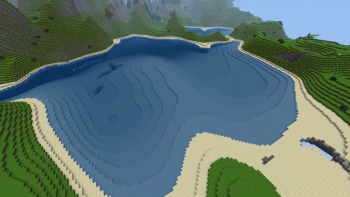Biomes/ja
| English • Deutsch • français • Bahasa Indonesia • 日本語 • Bahasa Melayu |
|
|
これは不完全な翻訳です。 お時間があるときに翻訳を完了させてください。 |
Minetestのバイオームはマップジェネレーターの一部です。バイオームとは、同じような地表や地下、植生を持つ領域のことです。
バイオームの種類
バイオームは、使用するマップジェネレーターに依存します。ほとんどのマップジェネレーターは同じバイオームを持っていますが、v6だけ異なります。
注意: 「ブロック」の列に太字で書かれているブロックは、そのバイオームの地表で使われているブロックです。
v5, v7, valleys(渓谷), carpathian(カルパチア), flat(フラット), fractal(フラクタル)について
マップジェネレーターの違いなどについてはマップジェネレーターの概要をご覧ください。
これらのマップジェネレーターのバイオームはmodにより定義されています。定義されていない場合は、石の世界しか生成しません。そして、マップジェネレーターのバイオームは地形と紐づいていません。つまり、平原を含むどんなバイオームも平坦な場所や高度な山岳地帯にも生成される可能性があることを意味しています。
このセクションではMinetest Gameで使われているバイオームを紹介します。
陸上バイオーム
| 名前 | ブロック | 説明 | 画像 |
|---|---|---|---|
| 平原 | 草のついた土, 土, 石, 草, 花, 低木の葉, 低木の幹, ブルーベリーの低木の葉, ブルーベリーの低木の葉と実 |
Grassland has large amounts of Dirt nodes and Dirt with Grass blocks, on which flowers, Grass and bushes (including blueberry bushes) may appear naturally in this area. The underground is made of stone. | |
| 針葉樹林 | 針葉樹林のよごれた土, 土, 石, マツの木, マツの木の葉, Fern, 赤色のキノコ, 茶色のキノコ |
Coniferous forests grow in colder areas and are notable for their unique floor. They are filled with a dense vegetation of ferns and pine trees, which come in two different shapes: One with “square” canopies and a “pointy” one. Between the dense fern, occasional mushrooms can be found. Fallen pine tree logs (on which you can sometimes find a red mushroom) can be found as well. A similar biome is the taiga (see below). | |
| 落葉樹林 | 草のついた土, 土, 石, リンゴの木, リンゴの木の葉, ポプラの木, ポプラの木の葉, リンゴ, 花, 赤色のキノコ, 茶色のキノコ, 低木の葉, 低木の幹 |
Deciduous forests form in temperate zones and are home to apple trees and aspen trees. Like in other forests, logs of fallen trees can be found here. Deciduous forests are frequently bordering surrounding grasslands. | |
| 熱帯雨林 | 熱帯雨林のよごれた土, 土, 石, ジャングルの草, ジャングルの木, ジャングルの木の葉, 茶色のキノコ, スイレン |
Rainforests (or jungles) are made of large jungle trees which grow thickly packed together. Jungle Grass and Jungle Trees bearing Jungle Leaves spawn here naturally. On fallen jungle tree logs, brown mushrooms may appear rarely. | |
| サバンナ | サバンナの草のついたサバンナの土, サバンナの土, 石, サバンナの草, 野生の綿花, アカシアの木, アカシアの木の葉, アカシアの低木の葉, アカシアの低木の幹 |
The savanna is a dry land which is not a desert. It is populated with plenty of savanna grass and occasional acacia trees, acacia bushes and wild cotton. There are also a few fallen logs of acacia trees. | |
| 砂漠 | 砂漠の砂, 砂漠の石, 砂岩, 砂漠の砂岩, 砂 サボテン, 枯れた低木 |
Deserts contain large amounts of desert sand and desert stone. In the desert stone, there are continuous strata of sandstone and desert sandstone that extend throughout the world. Small blobs of sand might be found in the desert stone as well. Cacti and dry shrubs also grow here naturally on desert sand. Cacti can form in two different shapes.
Deserts form in hot and dry areas. |
|
| 砂岩の砂漠 | 砂, 砂岩, 枯れた低木 |
Sandstone deserts are large barren areas covered by sand with sandstone below. They form in temperate and dry climates. | |
| 寒地荒原 | 銀の砂, 石, 銀の砂岩 枯れた低木 |
Cold deserts are large barren areas covered by large amounts of silver sand on top of stone. In the stone, there's a continuous stratum of silver sandstone that extends throughout the world.
This biome forms in cold and dry areas. |
|
| 雪原 | 雪, 雪のついた土, 土, 石, 低木の葉, 低木の幹 |
The snowy grassland biome usually borders grasslands and is completely covered by a thin layer snow on top of dirt with snow. A few snow-covered bushes can be found here. | |
| タイガ | 雪, 雪のついた土, 土, 石, マツの木, マツの木の葉, マツの低木, マツの低木の葉, 枯れた低木, 赤色のキノコ |
Taigas are cold snow-covered biomes with rich vegetation with snow and dirt with snow as surface. They are populated with snow-covered pine trees and pine bushes. Like in the coniferous forest, the pine trees grow in two different shapes. On fallen pine tree logs, red mushrooms can sometimes be found. | |
| ツンドラ | 雪ブロック, 石, 氷[1], 砂利[1] |
Tundras are barren biomes in very cold climates with no vegetation and a single layer of snow blocks on top of stone. They are usually found between taigas, snowy grasslands and glaciers. This is one of the few biomes where snow blocks (rather than just snow) naturally occur.
In the valleys mapgen, the rivers are frozen and made out of ice but they may be tricky to find because they are often buried below the snow blocks. Below the ice you can find a riverbed of gravel. |
|
| Ice Sheet | 雪ブロック, 氷, 砂利[1] |
The ice sheet biome forms only in the coldest regions and is made of large amounts of ice, covered by a thick layer of snow blocks without any vegetation. Ice sheet biomes can be either mountain-like, forming large glaciers as in the screenshot or very flat, creating large empty snow fields.
In the valleys mapgen, ice sheet biomes have frozen rivers like in tundras. |
砂浜、海岸、砂丘バイオーム
これらのバイオームは、陸上バイオームと海洋バイオームの間に生成されます。
| 名前 | ブロック | 説明 | 画像 |
|---|---|---|---|
| Grassland dunes, Coniferous forest dunes | 砂, マラムの草 |
Dunes are made of sand on which occasional marram grass grows. They form at 3-4 blocks above sea level and border grasslands and coniferous forests. | |
| Deciduous forest shore | 水, 土, スイレン |
A deciduous forest shore is the area exactly at sea level bordering deciduous forest biomes and has dirt as its floor (instead of sand). In the shallow water there is a chance to find waterlilies. | |
| Rainforest swamp | 水, 土, ジャングルの木, ジャングルの木の葉, スイレン |
A rainforest swamp is a small biome which only forms at sea level next to a rainforest. Rainforest swamps have jungle trees like the rainforest, but their roots are flooded with water. Waterlilies may occur here on shallow water. | |
| Savanna shore | 水, 土, パピルス, スイレン |
Savanna shores are usually small areas of shallow water with a dirt floor. They occur when a savanna reaches the sea level. There are plenty of papyri growing on single dirt blocks, but it is the only place in which papyri occur naturally. A couple of waterlilies may be found on the shallow water as well. | |
| Taiga beach | 水, 雪, 砂 | When a taiga meets the ocean, it creates sand beaches that are covered with sand. | |
| Tundra beach | 水, 雪, 砂利 | A tundra beach consists of lots of gravel with occasional snow and may form when a tundra meets the ocean. |
海洋バイオーム
Oceans are large bodies of water and have sand as the sea floor with occasional patches of clay. There are several ocean biomes in Minetest Game, one for each land biome. Each ocean biome has the same temperature and humidity requirements as its land counterpart.
The defining feature of the ocean biomes are, of course, the oceans, but they actually extend way below the ocean floor of most oceans, down to the Underground biome (see below). So ocean biomes also affect the appearance of the underground.
| 名前 | ブロック | 説明 | 画像 |
|---|---|---|---|
| Tundra ocean | 水, 砂, 粘土, 石, 鉱石 | The tundra ocean is the ocean biome that corresponds to the tundra. It could be seen as the “stereotypical” ocean biome, as the other ocean biomes share have most of the properties as this one. It has sand as the ocean floor, on top of stone. Like in all ocean biomes, blobs of clay are common inside the sand and occur between levels Y=0 and Y=-15. Ores generate in the stone. | |
| Taiga ocean, snowy grassland ocean, grassland ocean, coniferous forest ocean, deciduous forest ocean, cold desert ocean | 水, 砂, 粘土, 石, 鉱石 コンブ |
Like the tundra ocean, but on the sand there grow occasional kelp. | |
| Sandstone desert ocean | 水, 砂, 粘土, 砂岩 コンブ |
Ocean pendant of the sandstone desert. Like above, but it has sandstone instead of stone as underground material. Kelp grows here in the same manner. | |
| Savanna ocean, Rainforest ocean | 水, 砂, 粘土, 石, 鉱石 Coral (block), Coral (rooted), サンゴのしがい |
Savanna and rainforest oceans are the oceans bordering savannas and rainforests, respectively. Colorful coral reefs can form in the water close to the surface with all species of coral packed closely together. | |
| Desert ocean | 水, 砂, 粘土, 砂漠の石, サンゴ, サンゴのしがい |
Ocean variant of the desert. The underground material is desert stone. サンゴ reefs can form in the water close to the surface, in the same way as in savanna and rainforest oceans. | . |
| Ice sheet ocean | 雪ブロック, 氷, 水, 砂, 粘土 | Ice sheet ocean is the ocean pendant to the ice sheet biome (at land) and thus forms only in the coldest regions of oceans. This biome is named after the tall ice sheet that covers the ocean. The ice sheets are quite tall and consist of a single layer of snow blocks with up to 10 layers of ice beneath, “floating” above water in deep oceans. Shallow oceans and lakes might even be completely frozen. The underground below is either made out of ice or stone, creating interesting ice caves sometimes. |
地下バイオーム
This refers to the part of the world that is at or below Y coordinate -255 (directly below the ocean biomes) and it extends all the way to the bottom of the world, although most players would consider “the Underground” to be everything below sea level. Note the ocean biomes go very deep into the underground as well.
And indeed, most features of the underground biome, like ores, can be found in higher places as well.
| 名前 | ブロック | 説明 | 画像 |
|---|---|---|---|
| 地下 | 石, 空気, 銀の砂, 土, 砂利, 水, 溶岩, 鉱石 | This is a technical biome in Minetest Game and the only underground biome. It is almost exclusively made of stone, with occasional caves. There are occasional underground lakes of water and lava, making underground exploration slightly dangerous. Smaller blobs of silver sand (but not ordinary sand!), dirt and gravel can be found all around the underground, but these are common everywhere where stone can be found.
Since the underground is made out of stone, all the ores can be found here (although the ores are not restricted to this biome, in fact, they happily generate wherever stone can be found). The deeper you go, the more precious they become. Most of the time, the caves in the underground biome are indistinguishable from most caves in the ocean biomes, because of all the stone. This is not true for all ocean biomes. A transition from “ocean biome” to underground becomes obvious when you you started digging in a biome that doesn't have the (normal) stone, like the desert or sandstone desert biomes. In that case, the transition from the ocean biomes to the underground biomes is very visible, as can be seen in the screenshot to the right. Another sure sign that you're in an ocean biome, not the underground biome (yet) are clusters of (normal) sand, which don't exist in the underground biome. This is an oddity of the map generator which placed the ocean floor material inside a cave somehow. |
v6
Biomes in v6 are rather simple, but there are some unique features not found in other mapgens. This mapgen has a few biomes and 3 tree species. In, v6, the biomes do determine the terrain shape to some extent.
In Minetest Game, some blocks are not generated at all, but nothing essential. For example, there are are no aspen trees, acacia tree and corals.
Technically, the v6 map generator has a predefined set of biomes which can't be changed by mods directly. The outcome in different games will generally be very similar. Games usually only add to the v6 mapgen by creating so-called decorations, for example flowers and grass.
The distribution of v6 biomes can be seen here: File:Biomes_v6.png.
バイオーム
| 名前 | Main Blocks[2] | Decorations[3] | 説明 | 画像 |
|---|---|---|---|---|
| テンプレート | 草のついた土, 土, 石, リンゴの木, リンゴの木の葉, リンゴ |
草, 花, 茶色のキノコ, 赤色のキノコ, 蝶, ホタル | The Temperate biome (internally known as “Normal”) is the most common biome in v6 and forms in areas of medium heat. It includes grassy plains and apple tree forests. This biome is rather flat and covered by Dirt with Grass. The plains are large expanses of land.
In Minetest Game, Grass and flowers are spread over the entire biome; mushrooms may grow next to the apple tree trunks. |
|
| 砂漠 | 砂漠の砂, 砂漠の石 | サボテン, 枯れた低木 | Deserts hot and dry. They contain large amounts of desert sand and desert stone and often form large cliffs or canyons. Deserts are normally covered in desert sand, but at a few cliffs, the bare desert stone may be exposed without desert sand on top. Deserts spawn underground rivers and lakes which can be over 200 blocks deep.
In Minetest Game, Cacti and dry shrubs also occur here naturally in clusters on desert sand. The cacti form in a “column” shape of up to 4 blocks high. |
|
| ジャングル | 草のついた土, 土, 石, ジャングルの木, ジャングルの木の葉, Jungle Grass |
花, 草, 蝶, ホタル | Jungles hot and humid. They contain large jungle trees which grow thickly packed together. Jungle Grass and Jungle Trees bearing Jungle Leaves spawn here naturally.
In Minetest Game, flowers and Grass might appear here, but only rarely so, the jungle grass generally dominates in jungles. |
|
| タイガ | 雪のついた土, 石, 雪, マツの木, マツの木の葉 |
枯れた低木 | Taigas are cold and humid. The surface is covered with Dirt with Snow on top of 土 or 石. This biome includes snowed plains and snow-covered Pine Tree forests. In Minetest Game, some Dry Shrubs can be found here. | |
| ツンドラ | 雪ブロック, 雪のついた土, 石 | Tundras are cold and dry. They have large open fields with a surface of Snow Blocks on top of Dirt with Snow. There isn't any vegetation. They are essentially cold deserts. |
景観の特徴
Landscape features form (more or less) separately from biomes.
| 名前 | ブロック | 説明 | 画像 |
|---|---|---|---|
| 砂浜 | 水, 砂, 粘土, 石 | Sand beaches are made out of sand and form at at height of Y=2 and below, which is near the sea level by default. Sand beaches often extend deep into the ocean, which can easily turn a large part of the ocean floor into sand. The sand replaces the floor of other biomes. Depending on the terrain shape, sand beaches can be short or very long and wide (as seen in the screenshot). 粘土 can be found in the sand and forms in small to medium-sized “blobs” underwater (Technically, clay is generated like an ore by Minetest Game).
Sand beaches are generated based on height and Perlin noise; they technically form independent of the water of oceans. This effect can be noted if the water level (with the setting |
|
| 海 | 水, 石, 土, 砂 | An ocean is just a large body of water that reach a depth of around 25 blocks with the water surface at Y=0 worldwide (by default). The natural ocean floor is dirt (which is different from the other mapgens), but sand is also common because of sand beaches. Oceans usually spread across 250-300 blocks, but this can vary greatly. Oceans are a landscape feature that seemed to be implemented around 0.2.20110731_1 Pre-Alpha. | |
| 島 | All blocks from the v6 biomes, 水 | Islands occur many times in oceans. Islands usually raise out of the ground 3-10 blocks, but can get as large as 40-80 blocks tall. | |
| Ice sheet | 氷, 水, 土, 砂 | Ice sheets are two layers of ice on top of ocean water. They generate when a tundra biome hits an ocean. | |
| 山 | Blocks are similar to those of forests and plains | Mountains are the most treacherous to scale. Trees grow here naturally. It is quite easy to be killed in a mountain landscape if you don't pay attention to where you are going. | |
| 高原 | Almost all blocks from the v6 biomes | A giant structure that seems to have appeared from version 0.4 on, plateaus are very common in deserts but also in mountainous terrain. Plateaus can even float above ground and generate miniature biomes on top of it. | |
| Water cave | 水, 石 | Water caves are caves that only occur at sea level, which turn into a huge underground river or lake. In extreme cases, these caves can lead thousands of blocks down and are extremely easily to get lost in. | |
| Gravel field | 砂利 | Very rarely, unusually large gravel fields can appear on the surface. These areas consist of nothing but gravel. A gravel field can occour in any biome and simply replaced the surface material (e.g. dirt with grass) with gravel. |
v7
浮遊大陸バイオーム(実験的)
Floatlands is an experimental feature of the v7 map generator. They are disabled by default. To use them, they have to be enabled with the setting mgv7_spflags first.
Floatlands are floating pieces of land that float way above the ground level (Y=1280 by default). Like on ground level, there are various terrain shapes, like flat lands and huge mountains.
In Minetest Game, the floatlands have 3 simple biomes, as of 5.0.0. This might change in future versions. Also, all ores can be found in the floatlands frequently, they are often exposed at the bare terrain. But it's quite a hassle to go all the way up to the floatlands to reach them.
| 名前 | ブロック | 説明 | 画像 |
|---|---|---|---|
| Floatland grasslands | Same as grasslands, plus all ores | Floatland version of grasslands. This is basically the same, with the same ground blocks and vegetation. Like all floatland biomes, all the ores can be found here frequently. At the border of the floatlands, there are little sand “beaches” that are a bit shorter than in the ground-level grasslands. | |
| Floatland coniferous forest | Same as coniferous forest, plus all ores | Floatland version of coniferous forest. | |
| Floatland ocean | 水, 砂, 粘土, 石, 鉱石 | Floatland ocean are bodies of water that are actually more like big lakes. They have the same materials as most of the ground-level oceans but due to the nature of floatlands, they are shaped in a very different manner. Floatland oceans are also generally much smaller than the “real” oceans. Usually these are surrounded by enough landmass so the water is safely locked inside the floating island. But imperfections in the cave generator might still punch some holes into the floor, creating enormous waterfalls that slowly extend all the way down to the ground level. |
歴史
Minetestの開発
- Before Minetest had version numbers, biomes were undefinable and only consisted of 4 materials: grass, stone, light and “water” (as seen in the images).
- 0.0.1: It brought actual biomes to the table, but before 0.2.20110529 Pre-Alpha map generation was a bit of a mess. Biomes would cross into each other, and were generally undefinable.
- 0.3.0 and before: Biomes were very basic. There were only grasslands, forests, oceans and beaches.
- 0.4.0: The map generator version 6 was introduced. This map generator had the same biomes as before in its early versions. Deserts and later jungles have been added later.
- 0.4.13: Taigas and tundras have been added to the v6 mapgen. Around this time, work on the Biome API has begun, but it was not useful yet.
- 0.4.14: The Biome API has been introduced for the v7 mapgen which allows mods to create their own biomes from scratch. This was a major milestone because the Biome API is much more flexible than the hardcoded v6 biomes; the biomes can be much richer now. All mapgens now support the Biome API, except v6, which continues to have its hardcoded biomes.
- 5.0.0: Vertical biome blending was added which gives a more smooth transition between biomes that stack vertically. Biomes can also be limited by constant X/Y/Z coordinates. Biomes can replace the material of dungeons and the liquid in caves.
Minetest Gameのバイオーム
- Before 0.4.14: Minetest Game did not create any biomes; all biomes were created by Minetest instead. Minetest Game merely added some decorations to the v6 mapgen, like flowers, papyri, cacti, etc.
- 0.4.14: Minetest Game started to use the new Biome API which made the v7 mapgen finally suitable for playing. Minetest Game used the Biome API to add glaciers, ice sheets, tundras, taigas, stone grasslands, sandstone grasslands, coniferous forests, deciduous forests, deserts, savannas, rainforests, swamps and beaches. The v6 biomes are unchanged.
- 0.4.15: Snowy grasslands, cold deserts and sandstone deserts have been added. The sandstone grasslands have been removed.
- 5.0.0: Tundra, taiga and coniferous forest have been completely overhauled. The tundra is covered with large fields of permafrost and snow. The taiga and coniferous forests feature new styles of pine tree and have a new dirt floor with lots of ferns. In the rainforests, there are sometimes emergent jungle trees that have a thicker trunk and grow much taller. Sandstone strata added to desert and sandstone desert. On the dunes there grows now marram grass instead of grass. Kelp and rooted corals were added in the oceans.
関連項目
For more detail on the evolution of the map generator, see the Map Generator Evolution page.
















































